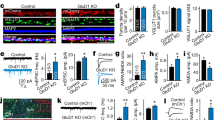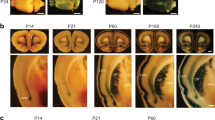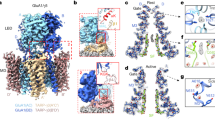Abstract
Ionotropic glutamate receptors (iGluRs) mediate most excitatory synaptic signalling between neurons. Binding of the neurotransmitter glutamate causes a conformational change in these receptors that gates open a transmembrane pore through which ions can pass. The gating of iGluRs is crucially dependent on a conserved amino acid that was first identified in the ‘lurcher’ ataxic mouse1. Through a screen for modifiers of iGluR function in a transgenic strain of Caenorhabditis elegans expressing a GLR-1 subunit containing the lurcher mutation, we identify suppressor of lurcher (sol-1). This gene encodes a transmembrane protein that is predicted to contain four extracellular β-barrel-forming domains known as CUB domains2,3. SOL-1 and GLR-1 are colocalized at the cell surface and can be co-immunoprecipitated. By recording from neurons expressing GLR-1, we show that SOL-1 is an accessory protein that is selectively required for glutamate-gated currents. We propose that SOL-1 participates in the gating of non-NMDA (N-methyl-d-aspartate) iGluRs, thereby providing a previously unknown mechanism of regulation for this important class of neurotransmitter receptor.
This is a preview of subscription content, access via your institution
Access options
Subscribe to this journal
Receive 51 print issues and online access
$199.00 per year
only $3.90 per issue
Buy this article
- Purchase on Springer Link
- Instant access to full article PDF
Prices may be subject to local taxes which are calculated during checkout





Similar content being viewed by others
References
Zuo, J. et al. Neurodegeneration in Lurcher mice caused by mutation in δ2 glutamate receptor gene. Nature 388, 769–773 (1997)
Bork, P. & Beckmann, G. The CUB domain. A widespread module in developmentally regulated proteins. J. Mol. Biol. 231, 539–545 (1993)
Varela, P. F. et al. The 2.4 Å resolution crystal structure of boar seminal plasma PSP-I/PSP-II: a zona pellucida-binding glycoprotein heterodimer of the spermadhesin family built by a CUB domain architecture. J. Mol. Biol. 274, 635–649 (1997)
Dingledine, R., Borges, K., Bowie, D. & Traynelis, S. F. The glutamate receptor ion channels. Pharmacol. Rev. 51, 7–61 (1999)
Sheng, M. & Kim, M. J. Postsynaptic signaling and plasticity mechanisms. Science 298, 776–780 (2002)
Kohda, K., Wang, Y. & Yuzaki, M. Mutation of a glutamate receptor motif reveals its role in gating and δ2 receptor channel properties. Nature Neurosci. 3, 315–322 (2000)
Maricq, A. V., Peckol, E., Driscoll, M. & Bargmann, C. I. Mechanosensory signalling in C. elegans mediated by the GLR-1 glutamate receptor. Nature 378, 78–81 (1995)
Hart, A. C., Sims, S. & Kaplan, J. M. Synaptic code for sensory modalities revealed by C. elegans GLR-1 glutamate receptor. Nature 378, 82–85 (1995)
Zheng, Y., Brockie, P. J., Mellem, J. E., Madsen, D. M. & Maricq, A. V. Neuronal control of locomotion in C. elegans is modified by a dominant mutation in the GLR-1 ionotropic glutamate receptor. Neuron 24, 347–361 (1999)
Stein, L., Sternberg, P., Durbin, R., Thierry-Mieg, J. & Spieth, J. WormBase: network access to the genome and biology of Caenorhabditis elegans. Nucleic Acids Res. 29, 82–86 (2001)
Gregory, L. A., Thielens, N. M., Arlaud, G. J. & Fontecilla-Camps, J. C. Gaboriaud C. X-ray structure of the Ca2+-binding interaction domain of C1s: insights into the assembly of the C1 complex of complement. J. Biol. Chem. 278, 32157–32164 (2003)
Mellem, J. E., Brockie, P. J., Zheng, Y., Madsen, D. M. & Maricq, A. V. Decoding of polymodal sensory stimuli by postsynaptic glutamate receptors in C. elegans. Neuron 36, 933–944 (2002)
Hilliard, M. A., Bargmann, C. I. & Bazzicalupo, P. C. elegans responds to chemical repellents by integrating sensory inputs from the head and the tail. Curr. Biol. 12, 730–734 (2002)
Rongo, C., Whitfield, C. W., Rodal, A., Kim, S. K. & Kaplan, J. M. LIN-10 is a shared component of the polarized protein localization pathways in neurons and epithelia. Cell 94, 751–759 (1998)
Christensen, M. et al. A primary culture system for functional analysis of C. elegans neurons and muscle cells. Neuron 33, 503–514 (2002)
Brockie, P. J., Mellem, J. E., Hills, T., Madsen, D. M. & Maricq, A. V. The C. elegans glutamate receptor subunit NMR-1 is required for slow NMDA-activated currents that regulate reversal frequency during locomotion. Neuron 31, 617–630 (2001)
Brockie, P. J., Madsen, D. M., Zheng, Y., Mellem, J. & Maricq, A. V. Differential expression of glutamate receptor subunits in the nervous system of Caenorhabditis elegans and their regulation by the homeodomain protein UNC-42. J. Neurosci. 21, 1510–1522 (2001)
Chelur, D. S. et al. The mechanosensory protein MEC-6 is a subunit of the C. elegans touch-cell degenerin channel. Nature 420, 669–673 (2002)
Michishita, M. et al. A novel gene, Btcl1, encoding CUB and LDLa domains is expressed in restricted areas of mouse brain. Biochem. Biophys. Res. Commun. 306, 680–686 (2003)
Stohr, H., Berger, C., Frohlich, S. & Weber, B. H. A novel gene encoding a putative transmembrane protein with two extracellular CUB domains and a low-density lipoprotein class A module: isolation of alternatively spliced isoforms in retina and brain. Gene 286, 223–231 (2002)
He, Z. & Tessier-Lavigne, M. Neuropilin is a receptor for the axonal chemorepellent Semaphorin III. Cell 90, 739–751 (1997)
Kolodkin, A. L. et al. Neuropilin is a semaphorin III receptor. Cell 90, 753–762 (1997)
Altschul, S. F. et al. Gapped BLAST and PSI-BLAST: a new generation of protein database search programs. Nucleic Acids Res. 25, 3389–3402 (1997)
Armstrong, N., Sun, Y., Chen, G. Q. & Gouaux, E. Structure of a glutamate-receptor ligand-binding core in complex with kainate. Nature 395, 913–917 (1998)
Shi, S., Hayashi, Y., Esteban, J. A. & Malinow, R. Subunit-specific rules governing AMPA receptor trafficking to synapses in hippocampal pyramidal neurons. Cell 105, 331–343 (2001)
Anderson, P. in Methods in Cell Biology (eds Epstein, H. F. & Shakes, D. C.) 31–58 (Academic, New York, 1995)
Wilson, R. et al. 2.2 Mb of contiguous nucleotide sequence from chromosome III of C. elegans. Nature 368, 32–38 (1994)
Gasteiger, E. et al. ExPASy: The proteomics server for in-depth protein knowledge and analysis. Nucleic Acids Res. 31, 3784–3788 (2003)
Acknowledgements
We thank M. Vetter and members of the Maricq laboratory for comments on the manuscript; L. Jack for generating transgenic strains; C. Walker, N. Strutz, M. Francis and A. Ebens for discussions; C. Rongo and J. Kaplan for the nuIs25 strain; and A. Gottschalk and W. Schafer for help with immunolabelling live worms. Some strains were provided by the Caenorhabditis Genetics Center. This research was supported by the Burroughs Wellcome Foundation, and by a grant from the NIH.
Author information
Authors and Affiliations
Corresponding author
Ethics declarations
Competing interests
The authors declare that they have no competing financial interests.
Supplementary information
41586_2004_BFnature02244_MOESM2_ESM.jpg
Supplementary Figure 2: Sequence alignment of CUB domains from various CUB domain proteins (modified from 11) and the 4 predicted CUB domains of SOL-1. (JPG 79 kb)
41586_2004_BFnature02244_MOESM3_ESM.jpg
Supplementary Figure 3: Confocal images of GFP (top), anti-GFP antibody staining (middle) and the merged images (bottom) in transgenic sol-1(ak63) worms that expressed GFP::GLR-2 (extracellular GFP) injected with Alexa 594 conjugated rabbit anti-GFP polyclonal sera. (JPG 91 kb)
Rights and permissions
About this article
Cite this article
Zheng, Y., Mellem, J., Brockie, P. et al. SOL-1 is a CUB-domain protein required for GLR-1 glutamate receptor function in C. elegans. Nature 427, 451–457 (2004). https://doi.org/10.1038/nature02244
Received:
Accepted:
Issue Date:
DOI: https://doi.org/10.1038/nature02244
This article is cited by
-
Physical Binding of Endothelial MCAM and Neural Transmembrane Protease Matriptase—Novel Cell Adhesion in Neural Stem cell Vascular Niche
Scientific Reports (2017)
-
Modulation of AMPA receptor function by auxiliary subunits
e-Neuroforum (2015)
-
Dancing partners at the synapse: auxiliary subunits that shape kainate receptor function
Nature Reviews Neuroscience (2012)
-
Net(o) excitement for kainate receptors
Nature Neuroscience (2011)
-
GRLD-1 regulates cell-wide abundance of glutamate receptor through post-transcriptional regulation
Nature Neuroscience (2010)
Comments
By submitting a comment you agree to abide by our Terms and Community Guidelines. If you find something abusive or that does not comply with our terms or guidelines please flag it as inappropriate.



